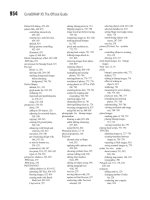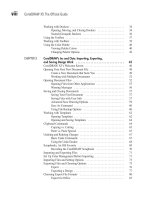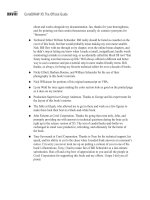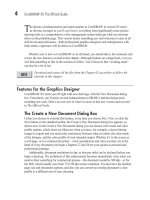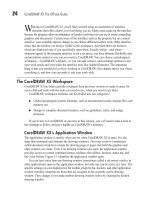CorelDRAW X5 The Official Guide part 7 potx
Bạn đang xem bản rút gọn của tài liệu. Xem và tải ngay bản đầy đủ của tài liệu tại đây (549.34 KB, 10 trang )
W
orking in CorelDRAW X5, you’ll find yourself using an assortment of interface
elements that offer control over everything you do. Many areas make up the interface
because the program offers an abundance of creative tools that you can use to create compelling
graphics and documents. Certain areas of the interface such as the property bar are context
sensitive: your available options change as you choose different toolbox tools. Other interface
areas, like the toolbox, are always visible in the workspace. And then there are dockers,
which are displayed only if you specifically open them. Exactly which—and where—
elements appear in the program interface is not a set piece; you have ultimate flexibility and
customization control so you can personalize CorelDRAW. You can choose a predesigned
workspace—CorelDRAW’s default—or you can add, remove, and rearrange options to suit
your work needs and even make the interface look like Adobe Illustrator. The important
thing is that you should feel at home working in CorelDRAW; this chapter shows you where
everything is, and how you can make it suit your work style.
The CorelDRAW X5 Workspace
CorelDRAW X5 has been carefully revamped from previous versions to make it easier for
you to find and work with the tools you need to use, when you need to use them.
CorelDRAW workspace elements can be divided into two categories:
●
Global and program control elements, such as measurement scales, backup files, and
memory use
●
Design or complete document features, such as guidelines, styles, and nudge
distances
If you’re new to CorelDRAW or just new to this version, you will want to take a look at
the roadmap to follow, and get a handle on CorelDRAW’s interface.
CorelDRAW X5’s Application Window
The application window is mainly what you see when CorelDRAW X5 is open. It is the
stage that surrounds and contains the drawing windows. Drawing windows (sometimes
called document windows) contain the drawing page or pages that hold the graphics and
other content you create. Even if no drawing windows are open, the application window
provides access to certain command menus, toolbars, the toolbox, dockers, status bar, and
the Color Palette. Figure 2-1 identifies the application window parts.
You can have more than one drawing window (sometimes called a document window in
other applications) open in the application window, but only one can be active at a time. The
specific settings you see displayed on the toolbar, property bar, dockers, and other application
window interface elements are those that are assigned to the currently active drawing
window. They change if you make another drawing window active by clicking the desired
drawing window.
24 CorelDRAW X5 The Official Guide
As in all standard Windows applications, clicking the Close button at the top right side
of the application window’s title bar closes CorelDRAW X5. Clicking the Minimize button
shows or hides CorelDRAW X5, and clicking the Maximize/Restore button quickly changes
the size of the application window itself. Clicking a drawing window’s Close button closes
the drawing window, removing it from the application window, while clicking a drawing
window’s Minimize or Maximize/Restore button minimizes it to a document title bar near
the bottom of the application window or restores it to size within the application window.
With CorelDRAW open and all documents closed, you can still perform many
necessary tasks. You can use File commands and open suite applications such as
Corel CAPTURE, Corel BARCODE WIZARD, Corel PHOTO-PAINT, and even
another copy of CorelDRAW with the Application Launcher. You can also use some
of Corel’s tool managers, work with macros, view help topics, and access Corel’s
online web resources through the Welcome screen.
CHAPTER 2: Exploring Your Workspace 25
2
FIGURE 2-1 CorelDRAW X5’s application window features these interface areas.
Program title bar Minimize
Maximize/
Restore
Close
Menu bar
Toolbar
Property
bar
Toolbox
Status bar
Minimized
drawing
window
Document
title bar
Color
palette
Docker
Ill 2-1
The Application Launcher on the application window’s toolbar allows you to open
another, unique copy of CorelDRAW, but simply because you can doesn’t mean you
should. Depending on how your memory preferences are set up in Tools | Options |
Workspace | Memory, you could potentially throttle your computer’s system RAM
and lose valuable work; the only reason you’d do this would be to copy objects
between documents. You can achieve the same result much more simply and with
less chance of a system halt by copying and moving objects between drawing
windows in a single session of CorelDRAW.
Drawing Windows
When a drawing window is fully maximized, it fills the dark gray space in the center of the
application window and looks as if it is part of the application window. When a drawing
window is open but not fully maximized, it is easy to see that it’s a separate window element
with its own interface elements that are unique to that drawing window.
Unlike the menu bar, property bar, toolbar, toolbox, Color Palette, and dockers, a
drawing window cannot be dragged outside of the application window and onto the desktop
or onto a second monitor’s desktop.
Not surprisingly, the interface elements that are contained within a drawing window
report on or control that specific drawing window. Like the application window, a drawing
window also has standard window controls such as a title bar that identifies the document’s
file path and name, as well as Minimize, Maximize/Restore, and Close buttons. Drawing
windows also have page borders, which (as with other windows) can be dragged to change
the size of the window. They also have scroll bars that are used to change your view of the
document’s contents.
Interface elements special to drawing windows include rulers; the document navigator,
which is used to add, delete, and move between pages in a multi-page drawing window (see
Chapter 6); the drawing page, which contains what can be printed; and the Navigator
button, which helps you move around a drawing without having to zoom out.
CorelDRAW X5 is compliant with the Microsoft Windows standard for multiple document
interfaces, meaning you can have more than one document (drawing) window open at a time.
To switch between drawing windows, choose Window | document name (where document
name is the actual name of your CorelDRAW X4 document). In Figure 2-2, you can see a
26 CorelDRAW X5 The Official Guide
basic and very useful drawing window technique: Suppose you have an object in one
document window and want a copy of it in a different one. You choose Window | Tile
Vertically (you can do this manually if you’re skilled manipulating windows in Windows),
and then move the object by just dragging it into the other window using the Pick tool. To
copy the object, hold the modifier key
CTRL as you drag from one window to the other.
CHAPTER 2: Exploring Your Workspace 27
2
Parent and Child Window Buttons
A document’s Minimize, Maximize/Restore, and Close buttons are not located in the
drawing window frame when a drawing window is maximized in the application
window. The Minimize, Maximize/Restore, and Close buttons for the current drawing
window are grayscale, smaller in size, and placed just below the Minimize, Maximize/
Restore, and Close buttons that belong to the application window.
If you want to close a document window, but your attention is wandering a bit and
you are running on autopilot, it’s easy to make a mistake and click the larger, more
colorful Close button that belongs to the entire CorelDRAW application.
So save your work often and try to remember that the big, red button is for the
whole application and the smaller one is for the document at hand.
FIGURE 2-2 Working between drawing windows is accomplished by click-dragging using
the Pick tool.
Hold CTRL and click-drag to copy.
CorelDRAW uses a default naming system of Untitled-1, Untitled-2, and so on,
incrementing the number for each new document you open in the current CorelDRAW
session. You are given the chance (and you should take it) to give your drawing a more
meaningful name when you save the document by choosing File | Save or pressing
CTRL+S.
You can also open more than one document window showing the same document,
enabling you to work on one document in multiple windows. This is a particularly useful
feature when you need to zoom in close to work on a small area of a graphic, but you also
need to be able to see how your work on that area affects the whole composition.
Both windows are “live,” so you can edit in either of them, and all the changes you make
editing in one window will also appear in the other window, because these windows represent
different views of the same document, not two independent files that can be saved as different
versions.
To open another view of the active drawing window, choose Window | New Window. To
make one of the open views the active window, you can click that window, or you can also use
Window | document name:N (where N is the automatically applied view number). Open as
many windows as you need—this feature is limited only by your available system resources.
Ill 2-2
28 CorelDRAW X5 The Official Guide
Multiple views of
same document
Specifying Toolbar and Dialog Values
Many times when working in CorelDRAW, you need to enter measurements or numeric
values, choose options and states, and control the behavior of interface elements on toolbars,
in dialogs, and so on. CorelDRAW uses a wide variety of standard input fields and controls
to make it easy for you to enter or tweak the specific kind of data you need. This section
guides you through the ways data can be entered and alerts you to some of the extra power
and usability Corel engineers have given these interface elements.
●
Num boxes To specify values, you’ll find num boxes—short for numeric boxes.
Usually a value already is in the box, such as the page width in the following
illustration. Just highlight the existing value using a click-drag action, and then type
a new value. Alternatively, you can double-click to select the entire value in the num
box before typing the value you want. If you insert the cursor at any point in the
existing value, you can use your keyboard arrow keys to move within the value and
then backspace to remove the number entry, then adding the value you need. Finally,
you need to confirm the value you entered by pressing…
ENTER. Press TAB to
quickly move your cursor from one num box to the next in the group, or press
SHIFT+TAB to move to the previous box. In dialogs, clicking the Apply button
applies the new options and leaves the dialog open; clicking OK closes the dialog
and applies the new values or options. On toolbars, pressing
ENTER after typing the
value does the same thing, as shown here.
Ill 2-3
CHAPTER 2: Exploring Your Workspace 29
2
Highlight the existing value; then type in the value you need.
Here’s an unexpected convenience: you can perform calculations in num boxes
using simple math equations to arrive at a value you need. Type symbols between
values to create the equation sequences. Use your plus (+) and minus (
) keys for
adding and subtracting, and your asterisk (*) and forward slash (/) keys for
multiplying and dividing. Pressing
ENTER performs the calculation. Naturally, you
can’t enter invalid keystrokes in a value box, such as alphabet letters—you’ll just
get a system beep after pressing
ENTER, and the previous, proper numerical value
will reappear.
●
Combo boxes Combo (short for combination) is a num box with a clickable
selection button for access to preset values. You can enter a specific value into a
combo box either by typing, or by choosing a preset value from the selector. Toolbar
and docker combo boxes often require pressing
ENTER to apply the new value you
type in, while clicking Apply or OK in dialogs does the same thing.
Ill 2-4
●
Flyout option menus On certain toolbars and dockers, you’re going to find flyout
menus, which are often accessed by clicking a button that has a small, triangular-
shaped, flyout arrow pointing to the right. For example, you can spot a tool on the
toolbox that has extended options you access from the tool button by a tick mark on
the button’s lower right. Flyouts often contain ways to change behavior states, apply
commands, and access options. Some apply options immediately, while others
require that they be closed first using the small X symbol usually found at the upper-
right corner. Examples of each are shown in the following:
30 CorelDRAW X5 The Official Guide
Enter value or click button
to select preset value.
Ill 2-5
●
Color selectors Color selectors often appear in dialogs or toolbars as a clickable
button that has the secondary function of displaying the currently selected color, as
shown here. Clicking opens a selector to display the current color palette and
requires you to click once to specify a color. Most color selectors also include the
Other button, which is a shortcut to color models, mixers, and palettes (covered in
Chapter 17).
Ill 2-6
●
List selectors List selectors differ from combo boxes in that you cannot enter a
value, but instead pick from a predefined list of values or graphic samples that show
the way that a style or arrow (or similar) will be applied or created, as shown on the
next page. Clicking one of the entries in the list chooses and applies a value, size,
state, mode, or style to the currently selected object. These lists are occasionally
called drop-down lists in other applications and pull-down lists in Apple’s OS X.
CHAPTER 2: Exploring Your Workspace 31
2
Flyout arrow
Flyout menu
Tick mark
indicates
popout menu.
Popout menus
Click to access a complete set of color
mixers and digital color models.
Ill 2-7
●
Radio buttons and option boxes These two interface devices are slightly
different, not just in shape, but also in the choices they offer, as shown next. Radio
buttons are round, come in groups, and only allow you to select one of the options in
the group at a time. Option boxes are square and let you choose an option or state to
be either on (with a check mark) or off (without a check mark). You’ll find in many
areas of the Options pages that you can choose more than one option (more than one
box can be checked) at a time.
Ill 2-8
●
Buttons Buttons appear throughout CorelDRAW and can do one of several things.
Command buttons perform commands instantaneously, but toggle buttons control
(and indicate) a specific feature’s On and Off states, using a pressed or not pressed
appearance. Generally, a pressed state indicates On, while the not pressed state
indicates Off. Shortcut buttons open dialogs to further options, while selector
buttons open lists of preset selections.
32 CorelDRAW X5 The Official Guide
Click to access preset values.
Click to activate the option.
Click to choose between options.
Ill 2-9
●
Spinners Spinners (also known as spin boxes) are similar to combo boxes, in that
they can be used to specify values by typing or by using mouse actions. Single clicks
on the up and down arrow buttons increase or decrease the values incrementally, but
you can also click-drag on the divider between the two arrow buttons—up to increase
or down to decrease the value.
Ill 2-10
●
Sliders You use sliders to specify values within a given range—often between 0
and 100 and often based on percent—by entering values, or by dragging a control
slider, which is intuitive and provides the anticipated results. To manipulate a slider
value, use a click-drag action to move the slider either right (to increase) or left (to
decrease), as shown here on the property bar after the Interactive transparency tool
has been used.
Ill 2-11
●
Pop-up menus To access pop-up menu commands and options, click your right
mouse button (instead of the typical left-click) on any given point. The pop-up menu
appears at the tip of your cursor (as shown on the next page) and closes automatically
after a selection is made or by clicking elsewhere in the interface. Pop-up menus are
sometimes called contextual menus, and a right-facing arrow next to a pop-up menu
item indicates that there’s a submenu with still more options, usually relating to the
main menu option.
CHAPTER 2: Exploring Your Workspace 33
2
On (active)
Off (inactive)
Highlight existing value;
then type value in the box.
Click to increase/decrease.
Click-drag to increase/decrease.
Enter value.
Click-drag to increase/decrease.
